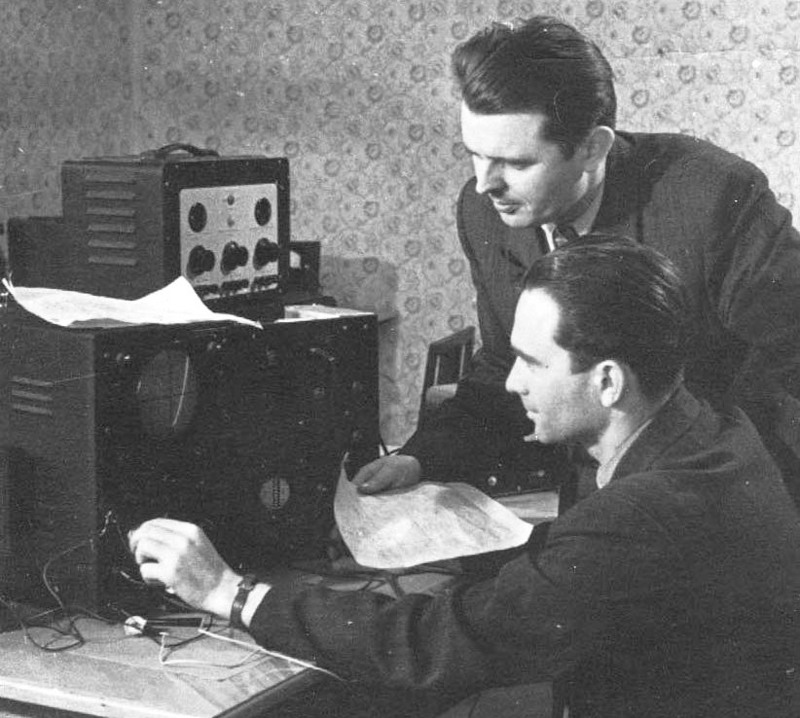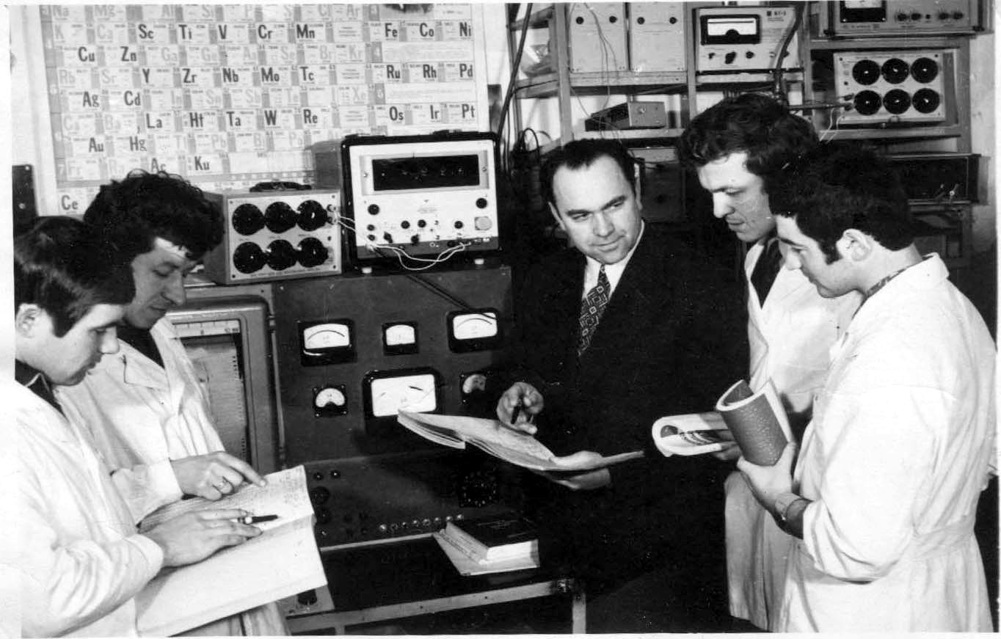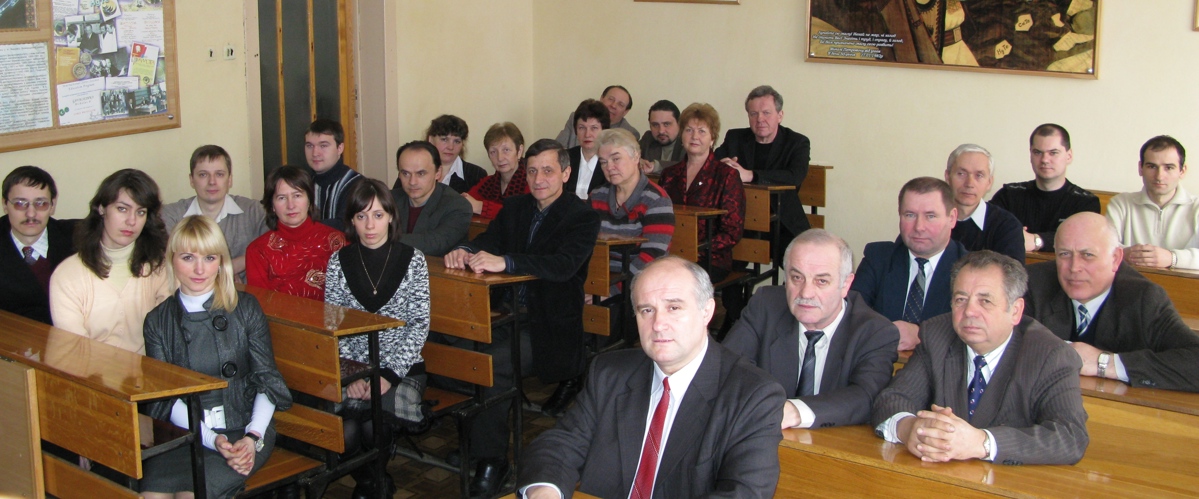In 1954, on the basis of the Department of Electron-Ion Processes (which in turn was created in 1949), the first Department of Semiconductor Physics in Ukraine was opened, headed by Professor Anatoliy Samoilovych, and from 1956 to 1971, this department led by prof. Korniy Tovstyuk. From 1971 to 1996, the department was headed by Prof. Mykola Gavaleshko, and from 1996 to 2009 the department worked under the leadership of Professor Petro Gorley. From 2009 to 2020, the department was headed by Professor Pavlo Maryanchuk. Since 2021, the department is headed by D. Sc., Prof. Eduard Maistruk.

K. Tovstyuk and graduate student M. Gavaleshko in the 60s of the 20th century
From 1968 to 1971, the Department of Microelectronics was headed by Assoc. P. A. Kotsyumakha, from 1971 to 2004, the microelectronics department was headed by professor, honored worker of science and technology Ilary Rarenko. In 2004, the department was renamed to the Department of Physics of Semiconductors and Nanostructures. From that time until 2016, the department was headed by Professor Andriy Savchuk. From 2016 until the liquidation of the department in 2020, it was managed by associate professor Victor Strebezhev.
The modern name of this scientific and educational center is the Department of Electronics and Power Engineering. Here intensive research was carried out in the field of multi-electron theory of semiconductors such as germanium, intermetallic semiconductors, new semiconductor materials were studied, the peculiarities of their energy structure, the nature of chemical bonding, and scattering mechanisms were clarified. Measurements of the magnetic susceptibility of semiconductors and its anisotropy are set at a high level (Mycola Havaleshko, Eugeniy Slynko, Andriy Savytskyi). In 1958–1966, 11 graduate students studied at the department, who defended their candidate theses during 1963–1966 (I. Potykevich, M. Havaleshko, A. Savytskyi, Y. Bujak, Y. Stakhira, D. Bercha, M. Tarnavska, P. Staryk, P. Voronyuk, O. Borets, N. Yakymova, etc.).

Mycola Havaleshko and his students: Frasunyak Vasil, Savchuk Andriy, Radevich Yarema and Khomyak Volodymyr 70s of the 20th century
The most important scientific results of the Department of Electronics and Power Engineering should be considered: the discovery of electron gas paramagnetism in narrow-band semiconductors (M. Gavaleshko, K. Tovstyuk); establishment and study of impurity and intrinsic defects in AIIВVI crystals (A. Savytskyi, K. Tovstyuk, V. Matlak, E. Nikonyuk, O. Parfenyuk); establishing on the basis of studies of the magnetic susceptibility of semimagnetic semiconductor solid solutions on the basis of АIIВVI the nature of clusters and the mechanisms of transformations in the cluster and defect subsystems of crystals during their heat treatment and the identification of the peculiarities of the kinetic properties of these crystals caused by the interaction of charge carriers with the cluster subsystem and the change in the non-parabolicity of the band spectrum when the composition changes solid solution and temperature (P. Maryanchuk, E. Maistruk); initiation of a new direction of cheap and environmentally friendly electronics based on the "pencil-on-semiconductor" concept, which involves a very simple and cheap technology for manufacturing photosensitive heterojunctions of the Schottky diode type and flexible photodetectors by directly drawing or transferring graphite films on the surface of semiconductor substrates (P. Maryanchuk, V. Brus); production and research of planar and nanostructured heterojunctions and Schottky diodes by sputtering thin films of metals, their oxides and nitrides, and graphite on semiconductor crystals (with a smooth and modified surface) (P. Maryanchuk, M. Solovan). In 1984–2008, the department trained 10 D. Sc. (M. Gavaleshko, A. Savytskyi, P. Staryk, P. Gorley, A. Savchuk, D. Zayachuk, G. Hrushka, S. Paranchich, P. Maryanchuk, O. A. Parfenyuk) and 30 candidates of sciences.

The staff of the Department of Electronics and Power Engineering, 2010.
At the same time, the microelectronics department conducted research on the creation of radiation-resistant microelectronics. On the basis of new technologies for growing semiconductor crystals and obtaining heterostructures based on them during field and laser surface treatment, the development of highly efficient devices of microphotoelectronics, IR technology was carried out (I. Rarenko, B. Hrytsyuk, E. Kosenkov, Y. Kushnir, A. Ashcheulov , S. Kulikovska, R. Plashenkov, etc.). The scientific output of this department is more than 900 printed works and 58 certificates for inventions. 6 employees of the department are laureates of state and personal awards (I. Rarenko, A. Ascheulov, B. Hrytsyuk, S. Kulikovska, E. Kosenkov, R. Plashenkov). During its existence, the department has graduated more than 900 specialists in the specialty "Microelectronics and semiconductor devices"
Since 2012, the following specialties have been licensed and accredited at the departments of electronics and power engineering and physics of semiconductors and nanostructures: 171 Electronics, 141 Power engineering, electrical engineering and electromechanics, 153 Micro- and nanosystem engineering.
The Department of Electronics and Energy maintains fruitful scientific contacts with leading educational institutions and scientific institutes of the USA, Germany, Italy, Sweden, Poland, and the Czech Republic. Graduates of the department successfully do internships and work abroad: University of California Santa Barbara (Santa Barbara, USA), Institute of Silicon Photovoltaics of the Berlin Helmholtz Center for Materials and Energy (Berlin, Germany), University of Massachusetts Lowell (Lowell, USA), Polytechnic University of Turin ( Turin, Italy), Lund University (Lund, Sweden), Charles University and Polytechnic Institute (Prague, Czech Republic), Ghent University (Belgium), where there is active international cooperation in joint research works, in the organization of international conferences.
The originality of the developed research methods and technology for growing crystals and films and manufacturing heterostructures is protected by about 100 patents and copyright certificates. Over 60 years, the Department of Electronics and Power Engineering has trained more than 2,000 highly qualified specialists, including 20 doctors and more than 100 candidates of sciences. Now the teachers of the department are 3 doctors of science, professor Eduard Maistruk, associate professor Mychailo Solovan, assistant Oleksiy Slyotov and 11 candidates of sciences, among the educational and support staff - 2 candidates of sciences; employees of the scientific sector of the department include 1 candidate of sciences.
The scientific school in the field of physics of semiconductors and semiconductor devices, started by the Honored Worker of Science and Technology of Ukraine, D. Sc., continues to function at the department, by Professor A. Samoilovich, developed and expanded by his student, D. Sc., by professor, corresponding member of the Academy of Sciences of Ukraine K. Tovstyuk, directed in an experimental direction by D. Sc., Honorary Professor of ChNU, Professor M. Havaleshko (postgraduate student of K. Tovstyuk). Dozens of candidate and doctoral theses were defended under the guidance of these outstanding scientists. One of M. Gavaleshko's students was D. Sc., Professor P. D. Maryanchuk, who continued with his students the traditional research of crystals and thin films of ordinary and semi-magnetic chalcogenide semiconductors and metal oxides, the technological conditions of manufacturing heterostructures based on them - electronic and solar energy devices, traditional for the department and its scientific school. On this scientific topic in recent years under the leadership of prof. Maryanchuk P. defended their theses and became teachers of the department: D. Sc., Professor E. Maistruk, PhD, associate professor Kozyarskyi D., PhD, associate professor G. Andrushchak, PhD, Associate Professor Kozyarskyi I., PhD, Assistant Mostoviy A., D. Sc., associate professor Solovan M., PhD, assistant T. Kovalyuk, PhD, assistant Parkhomenko H.
Therefore, the scientific school, which exists at the Department of Electronics and Power Engineering and is recognized by the Ukrainian and international scientific community, continues its operation and demonstrates new scientific achievements.